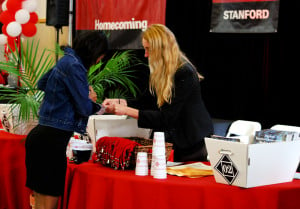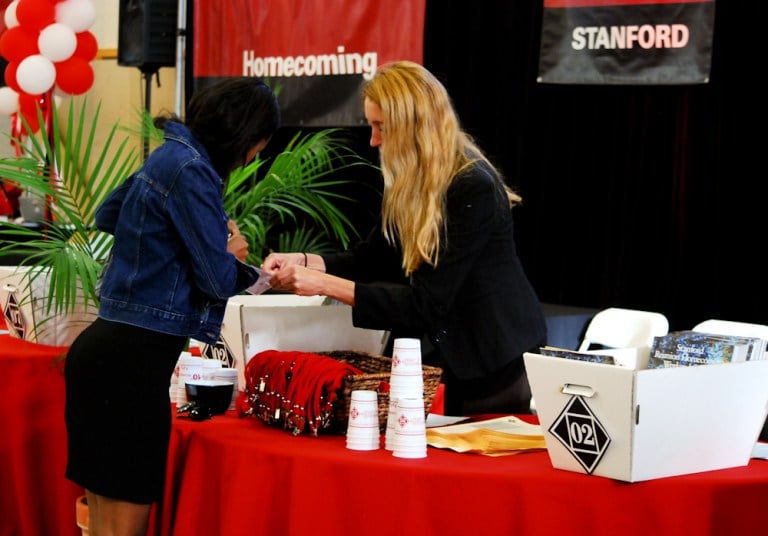Over 9,000 people, including 6,500 alumni and their guests, arrived on campus Thursday to celebrate Reunion Homecoming. Stanford’s largest annual alumni event, Reunion Homecoming debuted several new partnerships, including a new focus on the arts at Stanford, despite unprecedented logistical challenges.

“We plan Reunion 18 months in advance, and we found out 10 days before [the event] that the football game kick-off time had changed from five to noon,” said Leslie Winick, director of student class outreach for the Stanford Alumni Association. “So the big situation for us has been being super nimble about changing literally [everything]…we had a four-day event to event to event program planned for 9,000 people, and suddenly 10 days ago we had to redo all the materials, update 9,000 attendees, [redo] e-mails, websites, everything.”
The 116th incarnation of Reunion Homecoming since the founding of the Stanford Alumni Association, Reunion 2012 marked the beginning of a partnership with the Stanford Institute for Creativity and the Arts (SiCa). Pop-up art exhibits have appeared over the weekend at Tresidder and Old Union, in addition to significant emphasis on student arts on campus.
“We want to make the arts inescapable at reunions,” Winick said. “We’ve got student groups performing for alums on Saturday night at the CoHo, the Robber Barons [Stanford’s sketch comedy troupe] and the Stanford Improvisers are going to perform for alums]…we want to show off the new arts initiative.”
The weekend’s scheduling was complicated by the football schedule, which sees Stanford play only three home games while school is in session. Tailgates and a football game are a critical part of homecoming, so the Alumni Association was forced to host Reunion this weekend – the earliest ever, according to Winick – instead of at the end of October.
“We hire 500 students,” Winick said. “They had just gotten here. It was stunningly tricky and yet people pulled it off. Thank god for the registrar’s office helping us out, Event and Labor services, all the behind-the-scenes folks that make the University run.”
Winick, a veteran of 16 reunion weekends, said this year’s logistics have been by far the hardest to plan.
“Over 37 organizations and departments throughout campus are collaborators on reunions,” she said. “It really does take the entire Stanford community to do reunions right.”
The work is not all done on campus, however. Volunteer alumni have to make phone calls, organizational emails and event plans, all tailored to each class before Homecoming weekend.
“We’ll have well over 10,000 Stanford alumni volunteering for their alma mater,” president of the Stanford Alumni Association Howard Wolf ’80 said. “It’s very well unparalleled. As I talk to people who do what I do elsewhere in the country, Stanford stands out as a role model for how to engage volunteers.”
This year’s University Roundtable, moderated by ABC News correspondent Juju Chang ’87, explored the future of neuroscience and its application to everyday life. In addition, 65 faculty members volunteered to host “Classes Without Quizzes,” hour-long lectures on important issues of the day. For Winick, the academic focus at Reunion is what makes Stanford’s stand out.
“A lot of reunion programs are tailgates,” she said. “The cool thing about Stanford is that people come to see each other, but then they get a whole rich intellectual experience.”
For Patricia Hudson ’72 M.B.A. ’77, the academic panels and classes were a highlight of the weekend, especially in how they emphasized the Stanford ethos of provoking change in the world.
“I loved the [class] that Nick Bloom did on economics and [President Hennessey’s] panel on re-imagining education,” she said. “Everybody had the same message: ‘We take people who have the most potential to make a difference in the world, and we train them to make that difference.’”
Reunion Homecoming aims to re-engage returning alumni intellectually, but that doesn’t mean they don’t tailgate too. According to director of ticket sales and services Rich Muschell, alumni bought approximately 4,000 tickets to Saturday’s matinee against Arizona, a 54-48 Cardinal victory.
But besides returning for friends and football, alumni come to see how their school has changed – sometimes over several generations. Mary Rintalla ’32 was the oldest alumna on campus over the weekend at 101 years old, returning for her 80th reunion.
Some, like Hudson, raved about how much the campus has changed.
“The new Knight [Management School] is unbelievable, beautiful and very functional,” she said.
“[It’s been] 50 years and I’ve never enjoyed the campus as much as I do right now. Just the whole attitude and spirit of the place, it has grown from my day,” said Jay Tunney ’62.
But some praise was not without reservation.
“There’s a lot more grandness about the community…we used to call it the Farm,” Tunney said. “We don’t call it the Farm anymore. We call it the corporation.”
